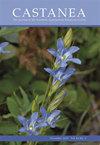Ozark Forest Forensics
IF 0.3
4区 生物学
Q4 PLANT SCIENCES
引用次数: 0
Abstract
Frederick Paillet and Steven Stephenson are sharing a story with readers. This story is rich with the knowledge, facts and understanding these two scientists have acquired about the Ozark Forest. Ozark Forest Forensics endeavors to describe a forest that to many is unfamiliar. Straddling the western edge of the eastern deciduous forest and the Great plains, the Ozarks are biogeographically, floristically, and climatologically distinct from the adjacent ecological regions. The authors attempt a comprehensive examination of a complex forest that does not characterize easily. Their tone is accessible, almost folksy, as the writers seem to address the reader directly; rather than a book about the Ozark forest, it is a book for those interested in the Ozarks. As they explain early in the book, the information, descriptions, and ideas are directed toward the Ozark sojourner, the hiker casually enjoying the forest. The aim to inform this hiker is admirable and important. In this regard, it serves as sort of reference in that we can imagine a hiker returning home after a long hike in the rugged Ozarks and wanting to know more about the curious plants, trees, geological formation that the hiker observed. While the deliverable is accessible, some of the many examples do require a bit of exploration for the reader. The book, therefore is not simply a field guide, but a field guide that requires some mental processes of the reader. The addition of a glossary does present the “feel” of a reference book! Although the Ozark physiographic region extends into Missouri, parts of Oklahoma, and even a bit into southern Illinois and eastern Kansas, this book is written from a decidedly Arkansas perspective. Given the authors’ familiarity with Arkansas, that is understandable, but there are distinctions in Missouri Ozarks that the reader would not be aware of. More contrast within that region and some examples of the Ozarks outside of Arkansas could help orient the reader more generally. With an Arkansas Ozarks emphasis, this book might disappoint those looking for more insight into Missouri Ozarks, but the authors cover broadly the important elements of the Ozark forest and therefore include many examples and unique areas that do apply to other forests, e.g. Missouri Ozarks. Other substantial ways that this book differs from a more standard field guide or forest history include the discussion of often neglected geological parent material. Geology and soil structure are often neglected when discussing forests and are critical to understanding Ozark communities. However, the intricate details of different geologic formations and the accompanying change in plant species composition could have been developed in more detail, because even slight variation in slope position, topography, and aspect result in dramatic changes in plant communities. The Ozarks include soils that are limestone residuum, sandstone residuum, and exposed igneous material—a wide range that influences plant and animal communities both overtly and with nuance. At times the style is slightly esoteric. For example, the chapter on “other forest realms” it is not clear on what the word “realms” refers to. After reading the chapter, it seems that “realms” might refer to natural communities, ecological land types, or simply different forest types. Introducing the readers to these terms would clarify otherwise complex topics. The reader may benefit from the authors’ having related the wealth of research on disturbance in forests of Missouri and Ozarks. Chronologies describing fire history, wind events, etc. have欧扎克森林取证
Frederick Paillet和Steven Stephenson正在与读者分享一个故事。这个故事是丰富的知识,事实和理解这两位科学家已经获得了关于奥扎克森林。奥扎克森林法医试图描述一个森林,对许多人来说是陌生的。欧扎克横跨东部落叶林和大平原的西部边缘,在生物地理、植物区系和气候上都与邻近的生态区截然不同。作者试图全面检查一个复杂的森林,不容易表征。他们的语气是平易近人的,几乎是平易近人的,因为作者似乎直接与读者交谈;它不是一本关于奥扎克森林的书,而是一本为那些对奥扎克感兴趣的人写的书。正如他们在书的开头所解释的那样,信息、描述和想法都是针对奥扎克的旅居者,那些随意享受森林的徒步旅行者。告知这位徒步旅行者的目的是令人钦佩和重要的。在这方面,它可以作为一种参考,因为我们可以想象一个徒步旅行者在崎岖的奥扎克长途跋涉后回家,想要更多地了解徒步旅行者所观察到的奇怪的植物、树木和地质构造。虽然可交付的内容是可访问的,但其中的一些示例确实需要读者进行一些探索。因此,这本书不仅仅是一本野外指南,而是一本需要读者进行一些心理过程的野外指南。词汇表的添加确实呈现出参考书的“感觉”!虽然奥扎克的地理区域延伸到密苏里州、俄克拉何马州的部分地区,甚至延伸到伊利诺斯州南部和堪萨斯州东部,但这本书显然是从阿肯色州的角度写的。考虑到作者对阿肯色州的熟悉程度,这是可以理解的,但密苏里州的奥扎克语有一些读者可能没有意识到的区别。该地区内部的更多对比以及阿肯色州以外的奥扎克人的一些例子可以帮助读者更普遍地定位。这本书以阿肯色州奥扎克为重点,可能会让那些想要深入了解密苏里奥扎克的人失望,但作者广泛地涵盖了奥扎克森林的重要元素,因此包括了许多适用于其他森林的例子和独特的区域,例如密苏里奥扎克。其他实质性的方式,这本书不同于一个更标准的野外指南或森林历史包括经常被忽视的地质母材料的讨论。在讨论森林时,地质和土壤结构往往被忽视,而这对了解欧扎克社区至关重要。然而,不同地质构造的复杂细节以及伴随而来的植物物种组成的变化可以得到更详细的研究,因为即使坡位、地形和坡向的微小变化也会导致植物群落的剧烈变化。奥扎克的土壤包括石灰石残渣、砂岩残渣和暴露的火成岩物质——范围很广,对植物和动物群落的影响既明显又细微。有时这种风格略显深奥。例如,在“其他森林领域”这一章中,“领域”这个词指的是什么并不清楚。读完这一章,似乎“领域”可以指自然群落、生态土地类型,或者仅仅是不同的森林类型。向读者介绍这些术语将澄清其他复杂的主题。读者可以从作者对密苏里州和奥扎克州森林扰动的丰富研究中获益。描述火灾历史、风事件等的年表
本文章由计算机程序翻译,如有差异,请以英文原文为准。
求助全文
约1分钟内获得全文
求助全文
来源期刊

Castanea
生物-植物科学
CiteScore
0.50
自引率
25.00%
发文量
28
审稿时长
>12 weeks
期刊介绍:
Castanea is named in honor of the American Chestnut tree. Castanea is thebotanical name for Chestnuts, dating back to what the ancient Greeks calledthem.
The American Chestnut is a critically endangered tree that once made up 35%of the forests of the Eastern US before being devastated by a blight thatdestroyed up to 4 billion American Chestnut trees.
Castanea serves professional and amateur botanists by reviewing andpublishing scientific papers related to botany in the Eastern United States.
We accept papers relating to plant biology, biochemistry, ecology, floristics,physiology and systematics.
 求助内容:
求助内容: 应助结果提醒方式:
应助结果提醒方式:


